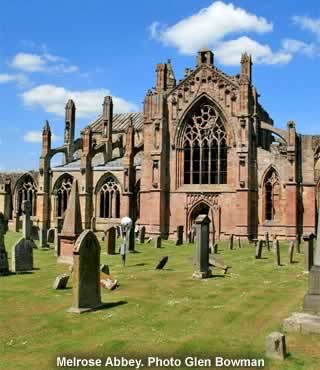Melrose Abbey |
|
 |
|||
The most important abbey in medieval Scotland |
||
The Cistercians were a fiercely strict order of Christian monks that came to prominence in the 12th century. They wore simple clothes, ate only a little food and spent much of their time doing manual labour. Their dedication was well-respected and, in 1136AD, Scotland's King David I asked them to set up a monastery in his country. |
||
The chosen location was at Melrose. Within the next couple of centuries, this new abbey had become one of the largest and most well-respected religious houses in Scotland. Its status was so high that King Alexander II was buried here in 1249. |
||
You wouldn't think that such simple, austere monks would have much use for money. In fact, thanks to their skill as labourers and farmers, the Melrose Cistercians were fabulously wealthy. They owned around 90 square kilometres of land, as well as 15,000 sheep. The wool from this giant flock was sold all over Europe. Unfortunately, such riches attracted unwanted attention. Melrose was extremely close to the border and, in the 1400s, the English attacked. The abbey was robbed, and burned to the ground. |
||
At the time, Scotland's monarch was King Robert I - better known as Robert the Bruce. He put his heart and soul into the rebuilding project, in more ways than one. Upon his death in 1329, Robert's heart was physically removed from his body. It was taken abroad, and used by the Scottish armies as a morale-boosting talisman. Shortly after these grisly adventures, his heart was brought home to Melrose, and buried here for eternity. |
||
As with many religious buildings, the abbey suffered a cruel fate during the reign of Henry VIII. It was badly damaged by his forces, and never repaired. The very last of its monks died in 1590. The ruins that still stand here date mostly from the 1400s, when the Melrose order's fabulous wealth allowed them to create the grandest abbey in Scotland. Even today, you can still see the elegant shapes and detailed carvings that made the building such a breathtaking place. Most of these decorations are understandably sombre; after all, this was a monastery. Nevertheless, if you look hard among the various arches and gargoyles, you'll find something a bit more light-hearted: there's a carving of a pig playing the bagpipes! |
||
To the north of the main abbey ruin is a quaint, little house, standing on its own in the grass. It was once home to Melrose's Commendator. This position was invented during Henry VIII's reign, in the monastery's later years. The Commendator was in charge of the abbey and its income, making this a prestigious job. Unfortunately, most of them spent the cash on their own wants, neglecting Melrose completely. The house has since been transformed into a museum, displaying all sorts of items found among the abbey ruins. |
||
After hearing about the Cistercians and their stern way of life, you may not want to don the robes and become a monk yourself! Even so, there can be no doubt that the order's dedication allowed them to perform some incredible achievements. Melrose Abbey remains Scotland's best example of their hard work. |
||
|
||
Melrose Abbey is open daily from 9:30am to 5:30pm (4:30pm from October to March). Entry costs around £5.50 for adults, £3.50 for children. Cloisters Road, Melrose, The Scottish Borders TD6 9LG. Tel: 01316 688 800 |
||
|
Pocket Britain is optimised for use on a smartphone or tablet with internet access. All content is subject to copyright. All reasonable methods have been used to ensure information supplied is accurate at the time of publication. However, it is advisable to check information before relying on it. Privacy Policy |